Water, plants, air, soil, and stone are Mother Nature’s gift to us.
Water gives us life, plants provide us with food, air gives us breathability, the earth offers us anchorage, and stone offers us stability. And these elements can be well incorporated into an aquarium.
Similarly, we get food from plants, and animals also relish the same benefit, more so aquatic wildlife. Thus when you decide to have a home aquarium, you must include plants that your fish can have as a nibbling snack or even just for aesthetic value.
If you want to make your aquarium a sight to behold, you should include some green in your creation. Sure, you may have plastic replicas, but what is the fun in that?
Get the real plants to make your aquarium a balanced atmosphere for your lovely water-borne pets. But what are the types of aquarium plants? And what exactly do water plants help with?
Here is a brief explanation about that.
Contents
Types of Aquarium Plants

Do you want to know what you are fertilizing? Therefore this section will help you further your knowledge on which type of aquatic plant you are dealing with, plus a few examples of each category.
Now, have a look at them below:
Foreground aquatic plants
These are the flora that is usually found at the front part of an aquarium. They are generally short and grow wider than higher. Some are named carpet plants since they spread on the ground like a carpet. Foreground plants take a long time to grow and fully cover the bottom side of the aquarium.
Examples of carpet plants are the Java Moss and the dwarf baby tears.
Mid-ground aquatic plants
These are the crops found after the foreground plants growing in the mid-section of the aquarium. Unlike the foreground plants, they grow vertically, and many can fit in a small area.
They are a bit taller and bushier thick enough to offer the fish and other aquatic animals a refuge to hide and breed. They can also be taking space at the edges of the tank as habitat.
Examples of these kinds are the Water Wisteria, the African Water Fern, the Amazon Sword, Java Fern, and the Dwarf aquarium lily.
Background aquatic plants
These are the plants that grow big with broad leaves and bushy foliage. They are usually very vegetative, and fish like using them for hiding when spooked. It is also the perfect location for fish to breed.
The plants mentioned in the mid-section could also be used as background plants, but others are like the Anubias and the Cryptocoryne Beckettii.
Why You Need Water Plants For Your Aquarium
To purify the air inside the water

Plants serve the same purpose in the water as they do on land. And that duty is to clean up the air inside the water. They absorb the ammonia and carbon dioxide found inside the water and give out oxygen, which the fish can breathe.
Indeed you may use a pump for this purpose, but why not make the work easier by employing plants? It is always better having both for your aquarium anyway.
They provide security and shelter
Sometimes the harsh bright lights in our homes and the constant movements can spook the fish and send them to hiding.
And where should they hide if they do not have any place to find refuge? Well, plants provide this fish and other aquatic animals in the tank a place to find security. These same plants could be used as breeding grounds, where the fish lay the eggs at the plants’ base.
They reduce the growth of algae
An algae is fish’s and any other aquatic animals’ enemy. It usually grows fast and ends up competing with the animal for nutrients.
Water flora can keep these algae growth in check, making the space conducive for the fish to thrive. Generally, your fish will become healthier and happier since they have all they require.
It aesthetically looks fantastic
Looking at two aquariums side by side, one with live plans and the other without, you will savor the beauty of the one with the aquatic flora.
Any landscape with plants looks peaceful, complete, and sustainable, which is the same feeling you get. You get your beautiful-looking aquarium, while your fish get an ecosystem that has all they need.
Now you see why you need to have the best aquarium plant fertilizer to make your water plants thrive? This piece will offer you five of the best in the market. So read on and find out what we have in store for you in the next section.
So without any further ado, below are the products.
Best Aquarium Plant Fertilizers
You also shouldn’t miss these other top picks on this category:
1. Best Overall: Thrive C By NilocG Aquatics

This product is liquid and by far the best aquarium fertilizer on this list. And that should tell you one thing- it is a superior brand with the best traits you are about to uncover. Keep reading.
Fertilizer facets
Thrive C comes in a white half a liter push bottle with a very subtle branding design. It is an all-in-one kind of product that caters to the lower-tech tanks with aquatic animals and plants.
It consists of essential micro and macronutrients that give plants a glow. The formula is non-glut; ergo, it is not harmful to any water flora or the fish. Some of the nutrients are Phosphates, Magnesium, Sulfur, Boron, Copper, Iron, and Zinc.
How to use
To use this aquarium plant fertilizer, you pump one milliliter for every five gallons of water at least twice a week, which means that you have to get some calculation done to not over-fertilize your water crops.
Bonuses
- The first benefit is that it is a very economical product that could last you a very long time since you need a bit for a substantial amount of water.
- The pump mechanism of dispensing is not messy and very convenient to measure your dosages.
- The mix of nutrients is everything your plants require.
- It is sufficient for most aquatic plants, including Java moss, Water Wisteria, and Java fern, to mention a few.
Limitation
- On the flip side, this fertilizer adds many nitrates into the water, killing some fish species.
- All In One: The all in one aquarium fertilizer contains all the essential micro and macronutrients that are required by your fish tank plants for proper growth and functioning. Just pump the bottle in the tank and let the aquarium plant food do its work.
- Appropriate Size: Unlike other low-quality products out there, our 500ml concentrated solution of aquarium plant fertilizer is concentrated enough to dose 2500 gallons of water. With its lasting impact, our fish tank fertilizer is going to be your new favorite.
- Practical Solution: With this balanced aquarium fertilizer you don’t need to calculate any more nutrients for your plants. This specially formulated liquid fertilizer helps you to keep your live aquarium plants vibrant, leafy, and healthy, without any hard work.
Procuring advice
One 500ml bottle of Thrive C, notably the best liquid fertilizer for aquariums, sells for approximately $25. Once you get the bottle, do not forget to do the calculation and follow the instructions. Test it out in small bits fast if you do not want the nitrates value in your tank to increase. Pro-tip— use half the dose!
2. Runner-up: Roots Tabs by API
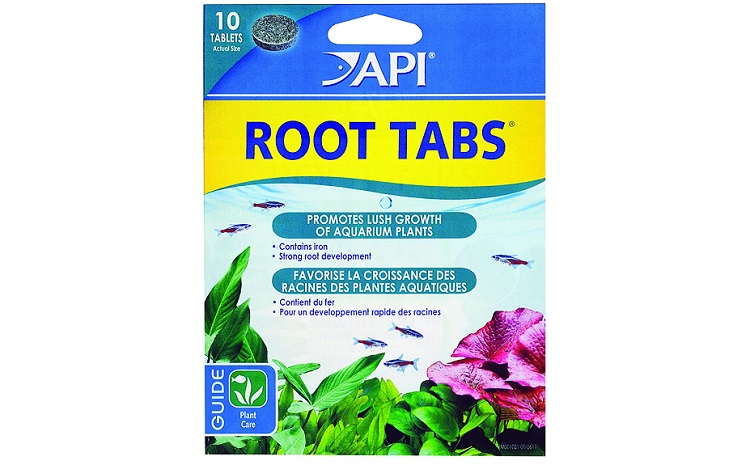
As the runner-up of the most effective aquatic plant fertilizers, this API plat nourishing product is a more direct product that focuses on the roots of the water crops. If you want your plants to have healthy roots, then this is the product for you.
Fertilizer facets
This fertilizer is specific for freshwater tanks. One packet is 0.704 ounces heavy, and it contains ten tabs of the fertilizer. It contains essential nutrients that are beneficial for the roots, and those are Carbon, Potassium, and Iron.
The potassium is ideal for giving the plant immunity to fight off disease. Iron aids the plant to reduce the nitrates and sulfate to facilitate energy production in the crop. These tabs are most useful for new plants introduced into the tank, but they can still be used on already existing flora.
How to use
To use the API Root Tabs, you burry one tab inside the gravel bed that anchors the plants once a month. Throughout the month, the nutrients will leech inside the soil and feed the crops through the roots.
Bonuses
- Ten tabs would comfortably take you through ten months, and this is a low-cost solution.
- The water nitrate levels are not affected in any way, and so the fish are not affected.
- Since the tab dissolves slowly, it has less residue floating in the tank, which makes cleaning a breeze.
Limitations
- Some clients attest that once they place tab inside the water, it dissolves immediately and fogs up the water, although the cloud settles overnight.
- Contains one (1) API ROOT TABS Freshwater Aquarium Plant Fertilizer 0. 4-Ounce 10-Count Box
- Promotes strong root development for lush plants in freshwater aquariums
- Contains essential nutrients including iron, potassium and carbon
Procuring advice
The API Root Tabs retails for approximately $9. And since a tab is used per month, it is estimated a whole package will take you through ten months. That said, it sounds like a petty sufficient product to use. Now you understand why it is the second-best aquarium fertilizer.
3. Alternative: Seachem Flourish Excel by the Seachem Store
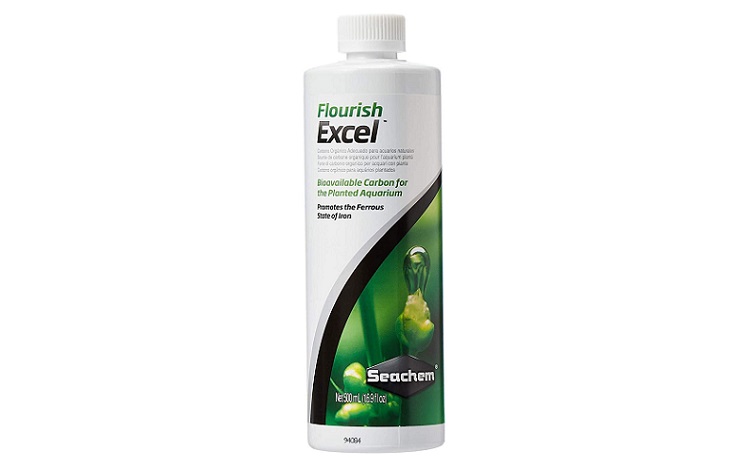
This is yet another liquid fertilizer, although this one is notably the best planted tank fertilizer, and you are about to find out why.
Fertilizer facets
The product comes in a 500ml plastic bottle to solve any carbon-related issues your plants might be facing. The Seachem Flourish contains elements that regulate healthy levels of Carbon and Iron in the plant.
These elements also increase the photosynthesis process, which is essentially the crop making food for itself. The formulation of the constituents is safe for all plants and animals in the aquarium.
How to use
To dose this aquarium plant’s food, you add one capful of the liquid fertilizer aquarium every ten gallons. Each cap equals five MLS. But that is only for the first time; for the second time, you append 5ml for every 200 water gallons daily or twice a week.
Bonuses
- This product enhances plant growth by amping up the essential processes for booming plants.
- It is a less-invasive solution to injecting carbon dioxide into the tank.
- The iron-reducing features ensure that the crops absorb Iron in the most useful ferrous Iron compared to the ferric Iron found.
- It is a safe option for both your plants and aquatic animals.
Limitations
- The dosage instructions are confusing, so it is easy to over-fertilize your crops and poison your animals.
- It is not the best product for ferns, Vallisneria, and mosses.
- CARBON PRODUCTION: All plants require a source of carbon, and Flourish Excel is a great and convenient source of bioavailable organic carbon.
- IRON PRODUCTION: Flourish Excel also possesses iron reducing properties, thus promoting the ferrous state of iron (Fe+2), which is more easily utilized by plants than ferric iron (Fe+3).
- PHOTOSYNTHESIS: Plants must produce longer chain carbon compounds (photosynthetic intermediates). By dosing with Flourish Excel you bypass the involvement of chain carbon compounds, and introduce the already finished, structurally similar compounds.
Procuring advice
One bottle of the Seachem liquid fertilizer for the aquarium costs approximately $9. Its efficiency and usage over a long period, plus the plants’ booms by optimizing their growth, make it a worthy buy. It is, for sure, a great alternative to the first two aquatic plant fertilizers.
4. Alternative: Highland Rim Aquatic Fertilizer by Winchester Gardens
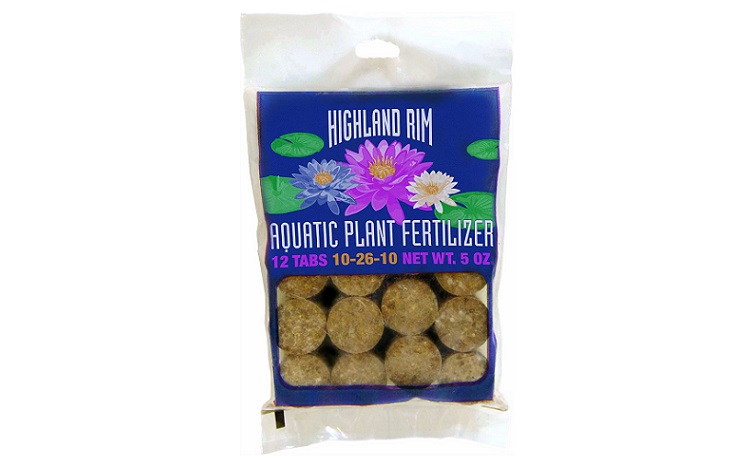
This aquarium plant food is specially formulated for lotus plants and water lilies. It offers new plants and exciting ones, the same amount of nutrients that optimize aquatic plants’ growth.
Fertilizer facets
The Highland Rim Aquatic Plant fertilizer is a dry aquarium fertilizer consisting of ten-gram brown tablets. One packet contains twelve packages. The formula is copper-free and non-toxic; hence it poses no danger to the aquatic life in the same tank as the fertilized flora.
This fertilizer is impressive since it promotes fertilized plants’ growth vigor, blooming potency, and resistance to disease and infestations. One packet weighs 3.8 ounces.
How to use
To use this aquarium fertilizer, you place one tablet into the soil or gravel. The dosage ratio is 1:1, meaning one tablet goes for one tab of fertilizer. For the lilies and the lotuses, you place a tab once a month, while for the marginals, you put one every six weeks.
Bonuses
- It works wonders to polish up the aesthetic aspect of your plants and boost the crops’ flowering.
- If you are making use of a tab a month, the whole package could take you an entire year. That is a low-cost fertilizer.
- The pellets are compact and do not disintegrate when placed in water.
Limitations
- This aquarium fertilizer is not ideal for an aquarium with fish; it kills some goldfish species.
- Specifically designed for water lilies and lotuses
- Copper-free formula (does not contain plant material)
- Safe and nontoxic, will not harm aquatic life
Procuring advice
One packet retails for about $13, and for a year’s worth of fertilizer, this is an aquatic plant fertilizer for the money. It gets your Lillies smiling, but it might kill your fish. For someone with a fish tank with water, lilies ought to go another fertilizer. But one with a plants only aquarium, then this fertilizer will do just fine.
5. Alternative: Pondcare Aquatic Plant Food Tablets by API

Finally, we have another API product known as the pondcare aquatic plant food tablets making the fifth of the best aquarium fertilizers in this article. Below is all you need to know about the product.
Fertilize facets
These tablets are packed in a ziplock blue, yellow, and green packaging. The tablets are circular grey-colored blocks measuring ⅝ and ½ inches. This dry aquarium fertilizer contains essentials like Iron, Phosphorous, Potassium, Magnesium, Boron, zinc, and Copper. It is a product that works throughout the year throughout all four seasons.
It gets the flora out of the earth in spring; it provides optimized and continual care in the summer. In autumn, it acts to prepare the life underwater for the winter. And during winter, it keeps the water circulating. One package is 0.25 pounds and contains twenty-five tablets.
How to use
The tablets are to be buried into the planting medium and allowed to leech into the soil. It is meant to be used in artificial aquariums and not natural ones. You commence using this fertilizer in the spring when the tank water is at an optimum temperature of 50-degrees Fahrenheit.
You place one table a month, but once the water temperature drops to 70-degrees, you add the dosage to two tablets a month. One tablet is enough to supply plants with 3.8 liters of water.
Bonuses
- This formula is very animal friendly and does not interfere with the fish or any other aquatic animal.
- The twenty-five pellets are more than enough to take you through a year of usage plus more.
- It is a treatment that works for the whole year.
Limitations
- Since you bury the tablet into the soil, it takes a while to see the results as the constituents must breakdown, get absorbed into the ground, then the roots into the plant.
- The requirement for utilizing this fertilizer is taxing since you need to keep the temperature to apply the tablet. It then requires you to get a thermometer, which is an extra cost.
- Contains one (1) PONDCARE AQUATIC PLANT FOOD TABLETS Potted Plant Fertilizer 3.8-ounce
- Contains essential nutrients and iron for lush green growth.
- Feeds pond plants and stimulates beautiful blooms all season long.
Procuring advice
This 25-tablet ziplock bag retails for $10 at all major outlets, including online. Taking a look at the economic aspect, if you are using, let’s say, one piece per month on average, it would take you around a year and a half to complete one pack.
We say 18 months since we are factoring the instances, you will use two tablets at a go. It is a worthy investment that will ensue in your aquarium plants appearing vigorous, hearty, and blooming all year round. So please select one and try it out.
Buyer’s Guide for the Best Aquarium Plant Fertilizers

If you’re a first-timer in taking care of aquatic plants with no idea of what fertilizer to use due to the numerous products available, work through the following considerations in this section to help narrow your options.
The Variety of Plant
The first thing to consider when buying your aquatic plant fertilizer is the plant type in your tank. There are various plant varieties, and their needs differ, although a few have the exact needs. Ensure to research the plant you have in your tank or the plant you are interested in to know their needs. That way, you will know the specific fertilizer that suits it.
Nutrients Present
Plants are living things, and they require a specific amount of minerals and nutrients to grow and flourish. When shopping for any fertilizer product, you must check the types of nutrients it contains and the amount. Ensure it includes the right amount of micro and macronutrients enough to satisfy your plant’s needs.
There are three essential macronutrients and eight micronutrients that an excellent aquatic plant fertilizer must have. They include:
Macronutrients
- Nitrogen (N)
- Phosphorus (P)
- Potassium (K)
Micronutrients
- Molybdenum (Mo)
- Cobalt (Co)
- Iron (Fe)
- Manganese (Mn)
- Boron (B)
- Nickel (Ni)
- Chlorine (Cl)
- Copper (Cu)
Remember that a balanced ratio of micro and macro nutrients is crucial. The reason is that an excess of either micro or macronutrients can lead to algae growth in your aquarium.
Form of Fertilizer and Ease of Use
Fertilizers come in different forms, and each has its pros and cons and is better suited for different plant types and tank setups.
Liquid fertilizers have more concentrated nutrients but need more work as you must apply them one to three times per week. In addition, they are easy to use but messy. For instance, as a first-timer, the worst thing you can do is pour liquid fertilizer into your tank unguided. This is because if you don’t handle liquid fertilizers with care, spillage is inevitable.
On the other hand, tablet fertilizers are easier to use as there won’t be any chance of spillage. All you need to do is press the tablet directly into the substrate of your tank and close it with either plants or another substrate. Once you have done that, there will be no need for replacement for a month or more.
Aquarium Community
Your aquarium community is one of the most vital things you must consider. If you intend to keep fish and aquatic plants, ensure the fertilizer you want to use won’t cause any harm to your fish.
For example, using a copper fertilizer harms snails and freshwater shrimp. It can cause instant death to them.
Aquarium plant fertilizers FAQ
Do I need to fertilize my aquarium plants?
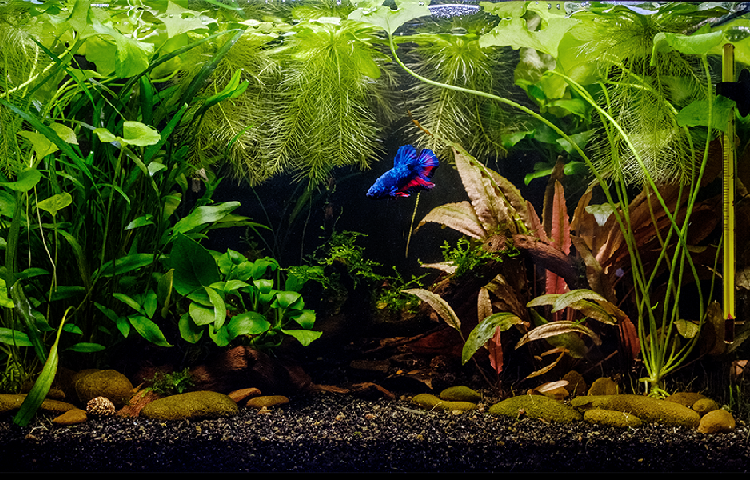
You may not need to in a perfectly conditioned aquarium, but why said you could not optimize your plant’s life?
And one of the ways to ensure that is by applying fertilizer. You have to note that if you do not provide the other essentials like light, then fertilizer for your crops may not do the trick.
However, you may choose not to use fertilizer, but your plants will do better with one.
Will plant fertilizer hurt my fish?
Some fertilizers will hurt your fish if they have toxic elements in the formula, but they won’t if what they contain is non-toxic.
The products discussed above will not unless you are careless with the dosage. If you use a pallet fertilizer or a liquid fertilizer in excess, the repercussions will be harmful to your aquatic pets.
That said, you must use the required dosage to avoid poisoning your fish. Suppose you notice your fish change behavior or die after using the product, consider reducing the dosage by half or stopping it altogether.
How often should you fertilize aquarium plants?
Each product featured in this piece has the instructed dosage indicated on the package. Some have a one-month application, others demand once every two weeks, while others are weekly.
So much so, conditioned on the dosage and type of fertilizer, make sure you adhere to the timeline required, the season, and quantity.
Can I use normal fertilizer in the aquarium?
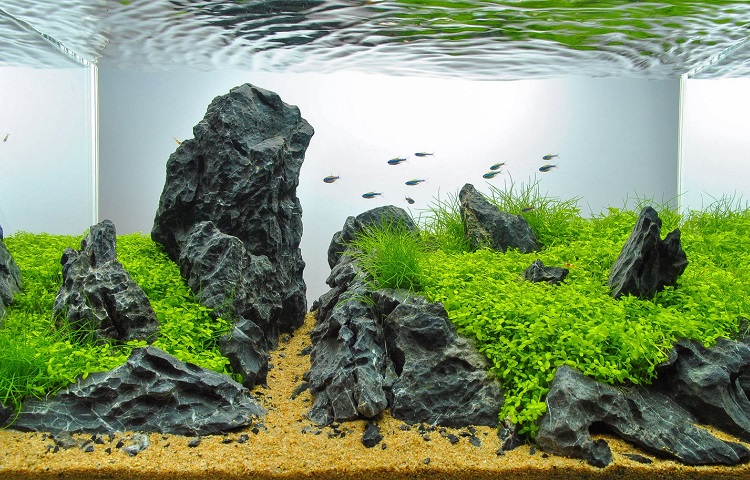
Yes, you can, but it is highly discouraged. Here is why:
Standard fertilizer is meant for dry soil and not water-logged soil as in the aquarium plant foods. And for that reason, any quantity applied will quickly dissolve and end up scorching the plant’s parts.
Usual fertilizers are also meant to be absorbed through the roots and not on any part of the plant, and since it may dissolve in the water, it may reach the leaves and the stem.
Regular fertilizer is also very toxic to animals, and so it will kill your fish the instance it gets into contact with the animals. Most of the elements are not animal safe and might even promote the growth of algae.
Some fertilizers may be labeled multipurpose for both dry soil and aquarium soil, and those are the kinds you can use. However, be sure to follow the latter’s directions since too much may kill your aquatic pets.
Conclusion
Suppose you have been searching for the best aquarium fertilizer; you most definitely now have five sufficient fertilizers to choose from.
The essential features of each have been highlighted. Therefore, you now know how to use each.
You even know how much each cost, so you have no reason not to get your plants the adequate aquarium plant fertilizer. If you want your crops to thrive, get one, and make your aquatic plants grow healthy. Your fish will also be ecstatic.

Ian Sterling, founder of Fishlab.com, began his aquarium journey over 30 years ago, driven by a deep fascination for fish and their diverse personalities. His website, Fishlab.com, is dedicated to making fishkeeping accessible and enjoyable, offering beginner-friendly guidance, expert insights, and a community for aquarists to connect and share experiences.


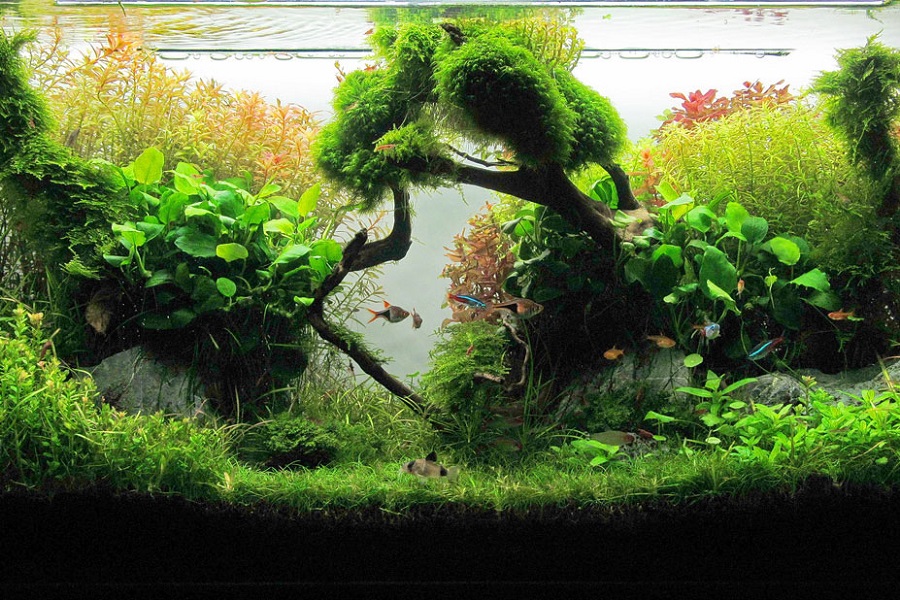
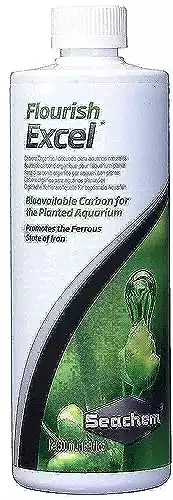

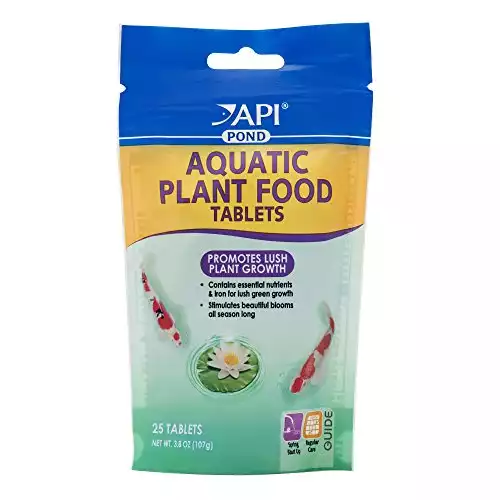





Comments (1)
Ian, I’ve had 2, 20gallon tank with guppy’s for several years now. (Male and female tank????) I have a pleco that I transfer from tank to tank to help with algae (we call him our shark). I do regular 1/3 water changes with gravel cleaning and carbon filter changes and I use Prime conditioner. The water is perfect BUT the smell seems to be a issue now. ???? I’ve been told to remove all fish and reserve as much water as I can.. clean all rocks and decor, then replace original water and fish leaving filter as is. I’m Sacred that will screw up my balance. Should I do that or do you have another solution? Thank you for you help!!!